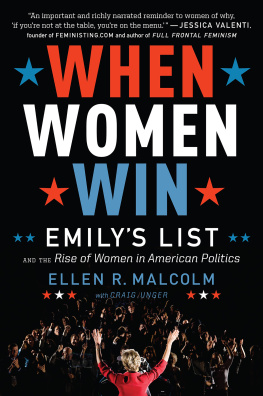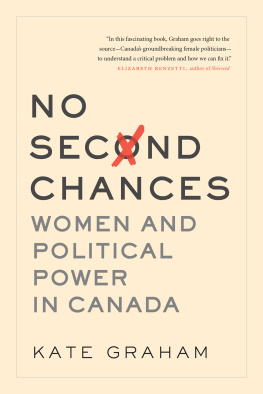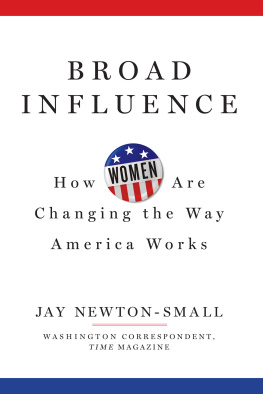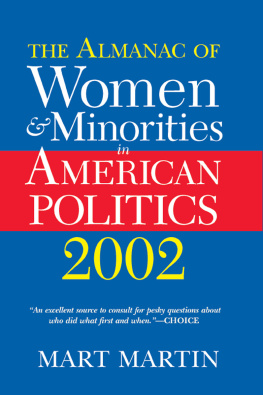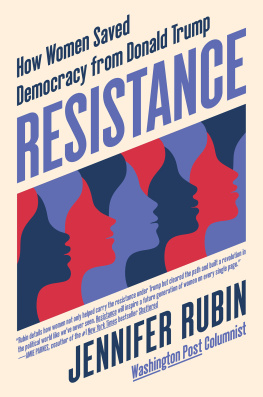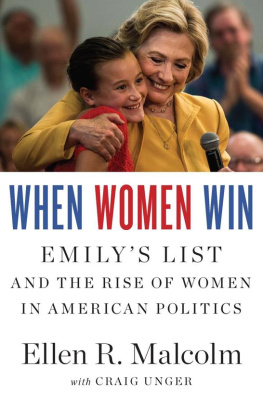First Mariner Books edition 2017
Copyright 2016 by Ellen R. Malcolm and Craig Unger
All rights reserved
For information about permission to reproduce selections from this book, write to or to Permissions, Houghton Mifflin Harcourt Publishing Company, 3 Park Avenue, 19th Floor, New York, New York 10016.
www.hmhco.com
The Library of Congress has cataloged the print edition as follows:
Names: Malcolm, Ellen, author. | Unger, Craig, author.
Title: When women win : EMILYs List and the rise of women in American politics / Ellen R. Malcolm with Craig Unger.
Description: Boston : Houghton Mifflin Harcourt, 2016. | Includes bibliographical references and index.
Identifiers: LCCN 2015037242 | ISBN 9780544443310 (hardcover) | ISBN 9780544443389 (ebook) | ISBN 9781328710277 (pbk.)
Subjects: LCSH: Women politiciansUnited States. | WomenPolitical activityUnited States. | United StatesPolitics and government1989
Classification: LCC HQ1391.U5 M35 2016 | DDC 320.0820973dc23
LC record available at http://lccn.loc.gov/2015037242
Small portions of , How to Beat Bubba, first appeared in How to Beat Bubba by Craig Unger in the New Republic, October 22, 1990.
Graph on courtesy of Kate Black, Vice President of Research, EMILYs List/Mapping Specialists, Ltd., Fitchburg, WI.
Cover design by Mark R. Robinson
Cover photograph Upper Cut Images
Author photograph Dave Moser
v2.0217
To those who dare to change the world:
the members, staff, and candidates of EMILYs List.
Introduction
The Last Glass Ceiling
ON THE AFTERNOON OF March 3, 2015, I arrived at the Washington Hilton to attend the thirtieth-anniversary gala for EMILYs List, the political network I founded in 1985. It was a jam-packed two-day celebration, and I had been looking forward to it for months.
Among the two thousand or so people attending the event, dozens of old friends had come not only from Washington, D.C., but also from Texas, Florida, New York, California, and all over the rest of the country. We had fought in the trenches together and forged powerful bonds. For three decades, we had shared a deep commitment to one simple but incredibly challenging mission: electing pro-choice Democratic women to office.
Young women today cant possibly imagine how quixotic that goal of getting women elected to political office seemed thirty years ago. True, the womens movement was well under way by the mid-eighties, and women had begun to join the workforce en masse. But having high-powered careers in law, medicine, business, or politics was a different matter entirely back then. It was for pioneers only.
Nowhere was that more evident than Capitol Hill. In 1985, 5 percent of the 435 elected officials in the House of Representatives were women. There were just two women among one hundred United States senators. And both female senators were Republicanswhich meant that my party, the Democrats, our most progressive political party, did not have a single woman in the Senate.
Not one.
Even worse, that had always been the case. In its entire history, the Democratic Party had never elected a single woman to the Senate in her own right. On several occasions, when a sitting senator had died, the powers that be had appointed his widow to fill her late husbands seat, and, at times, such women had even been elected to one or more subsequent terms. But when it came to electing a Democratic woman in her own right, that had never happened.
That numberzerospoke for itself: our representative democracy had almost completely ignored 51.4 percent of the population. Virtually no one in either major political party took women candidates seriously. For generations, the old boys network of both parties had kept women out of office. Those in the political establishment didnt think women could win, so they refused to contribute to their campaigns. And without any money to run serious campaigns, women candidates were doomed to defeat. It was a vicious cycle.
So, if you looked out on the floor of the House or the Senate in those days, you saw a forbidding sea of monochromatic suitsblack, blue, or dark grayworn by the men who had transformed the august legislative chambers of Congress into the worlds most exclusive mens club. How was it possible to think of the United States of America as a representative democracy when we failed to elect women to Congress?
The situation was grim.
SO, BIT BY BIT , EMILYs List assembled a terrific team of talented women, and we came up with a sophisticated marketing strategy dedicated to winning political parity for women. At times, we suffered bitter defeats. But we made progress in each and every election cycle until, over time, we had built a full-service political organization that, in addition to raising funds, trained people to be campaign managers, to track local campaigns, to oversee media, to win, and to govern. We battled an increasingly extreme-right Republican Party led by ruthless political operatives, such as Karl Rove, and retrograde Tea Party candidates, one of whom talked about legitimate rape in a way that was stunning. Yet we emerged victorious again and again and eventually became, at one point, the biggest and most powerful political-action committee in the United States.
And now, in 2015, at the Hilton, one could see exactly how successful we had been. If there had been an awards ceremony for women in politics, this would have been our Oscars. With celebrities like Anna Gunn of Breaking Bad, Connie Britton of Friday Night Lights and Nashville, and Padma Lakshmi from Top Chef, there was, in fact, even a bit of Hollywood glamour. But the most honored stars were women who had real political clout. There were U.S. senators and representatives, cabinet officials, and governors. There were political professionals we had trained or worked with: consultants, pollsters, fund-raisers, strategists, and more. There was a new generation of up-and-coming politicians such as Ayanna Pressley, the first woman of color to be elected to the Boston City Council and the recipient of our Gabrielle Giffords Rising Star Award. And finally, there were real presidential contenders both for now and for the future.
If a time-lapse portrait could depict everyone there and our shared achievements, it would show nothing less than the saga of a great social movement. That saga is the story of the rise of women in American politics. It tells how EMILYs List went from nothing more than an annoying thorn in the side of the old boys network of the Democratic Party to a powerful and highly valued partner that was absolutely essential to the partys success. It is the story of dozens of individual women who started out as envelope-stuffing activists, community organizers, local pols, or party officials, who never gave up and moved on, as a generation, into statewide politics, where some became governors, and into federal races, where they won seats in the House of Representatives and the United States Senateand they did not stop there.
It is the story of Barbara Mikulskis journey from being a scrappy street-fighting community organizer in Maryland to making history as the first Democratic woman elected to the United States Senate in her own right. It is the story of a California Democratic Party volunteer named Nancy Pelosi, who hosted a fund-raiser for EMILYs List at her San Francisco home in the eighties and went on to become the Speaker of the House. It is the story of how the legendary Ann Richards grew from a marginalized liberal activist to an iconic figure to millions of American womenand a great governor of Texas. It is the story of a demure law professor named Anita Hill who spoke out about her sexual harassment and who, after daring to come forth, was subjected to a demeaning and insulting interrogation by the then all-male Senate Judiciary Committee, thereby igniting the passions of tens of millions of voters who voted dozens of women into higher office. It is the story of a generation-long war against an entrenched male political establishment and an increasingly right-wing Republican Party, and of unlikely winsagain and again and again.
Next page
